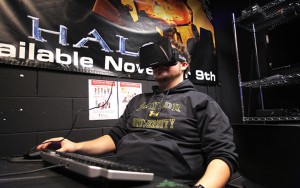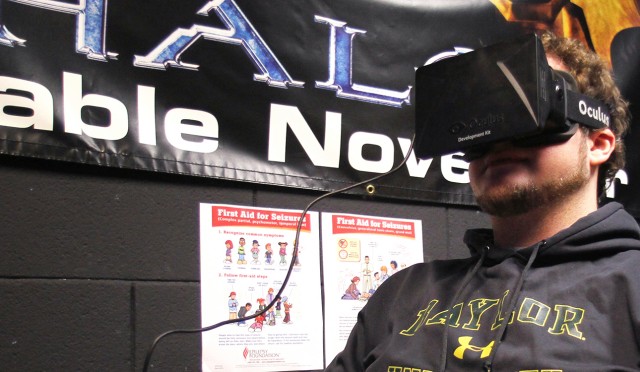
Travis Taylor | Lariat Photo Editor
Reporter
After years of research and imagining the innumerable possibilities, virtual reality is just now becoming a real possibility for video games.
Jonmichael Seibert, second-year graduate student, is researching a prototype model of Oculus Rift, a 3-D virtual reality headset.
“Virtual reality has been around for 20 years, and it’s been awful for 20 years,” Seibert said. “Last summer, with the Kickstarter for Oculus, I realized that virtual reality is back, and it actually works.”
Seibert said his experiences with virtual reality as a kid had so much anticipation and expectation for it to be great, but it ended up being very disappointing.
“I remember the first time I tried virtual reality was in 1996,” Seibert said. “I was so excited to try it out, but I got to play it and it was terrible. Bad game. Bad tech. Bad design. Now with the Oculus, developers can really see that virtual reality is real, and it actually does the job right.”
Seibert’s research is specifically focused on the psychological effects a person experiences when playing video games on the Oculus Rift.
Oculus improved past models of virtual reality with full 1080p high-definition display, stereoscopic 3-D, better frame rate and a nearly 360-degree view. Oculus is also more compact than the familiar bulky set-up with slow, choppy graphics and inaccessible to people outside of a rare theme-park attraction for virtual reality.
Many factors go into how a person psychologically, physically and emotionally reacts to a video game, Seibert said. Changing the screen size, control scheme or sound output each contribute to how a person reacts to video games.
Since the Oculus Rift changes so many of those variables, it can potentially change everything about how people experience games. Video games have the potential to revolutionize technology, education, cinema and culture altogether, Seibert said.
“During my research for this project, I read a figure that says the player base of World of Warcraft has collectively spent about 6 million years of gameplay,” Seibert said. “That is 6 million years of man hours gone into a virtual space.”
Seibert believes video games have a certain ability to motivate players. He said this ability can be turned into something useful other than World of Warcraft or escapism. Seibert said that people are more and more “ditching reality” and immersing themselves in games.
“There is obviously something in these games that gets people motivated,” Seibert said. “If we can take that motivation out of the virtual space and bring it into the real world and use it to motivate people, then that’s years of gaming well spent.”
Comparing and contrasting the current education system to video games, Seibert pointed out various differences of motivation between the two.
College, for example, essentially has students start with a 100% score, and the whole semester is basically “damage control” from there on out, Seibert said.
Video games, on the other hand, start players from the bottom and are only able to succeed if they complete the objectives the game has laid out for the player.
“With the Oculus, we’ll be doing a lot of student testing to look at immersion and enjoyment in video games,” Dr. Corey Carbonara, professor of film and digital media said.
Seibert graduated in Spring 2012 with a degree in film and digital media. He is currently working towards a master’s degree in communication studies.
Testing for Seibert’s project will begin in November.
Seibert said he will let students know when they can sign up and participate in the testing.



